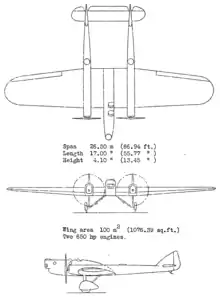| SPCA 30 | |
|---|---|
 | |
| SPCA 30 with the original landing gear | |
| Role | Bomber monoplane |
| National origin | France |
| Manufacturer | SPCA |
| First flight | 1931 |
| Number built | 2 |
The SPCA 30, also known as SPCA Type III, was a French bomber aircraft built by the Société Provençale de Constructions Aéronautiques (SPCA).[1][2]
Development and design

In 1928, the French Service Technique de l'Aéronautique (the government body responsible for producing specifications for aircraft for the Frech armed forces) drew up requirements for a four-seat Multiplace de Combat, a multi-role aircraft capable of day and night bombing, reconnaissance and long–range escort duties.[3] In response, SPCA designed an all-metal twin boom low wing monoplane, the SPCA 30, the only twin boom aircraft entered into the contest. The aircraft's central fuselage had two open cockpits offset to port, and a machine gun mount in the nose, while two more machine gun mounts were in the tailbooms.[4]
Two prototypes were completed late in 1930.[4] The first one, registration F-AKCA was fitted with two 485 kW (650 hp) Lorraine-Dietrich 18Kd water-cooled W engines engines, and made its first flight on 1 February 1931.[5][6] On 7 August, F-AKCA was being demonstrated at Villacoublay airfield when the aircraft suffered severe vibration when the engines were brought back to full power, with the tailbooms being displaced by more than a metre, leading to tearing of the skin of the aircraft's tailbooms. Despite the damage, the pilot managed to land the aircraft. The accident was eventually found to be due to flutter, caused by weakness of the wings in torsion (i.e. twisting), which was exacerbated by the unbalanced control surfaces.[7] The second prototype, F-AKCB, with two 650 hp Hispano-Suiza 12Nb engines, flew on 6 May 1933.[8] The original bulky landing gear was later replaced by a lighter one.
Operational history
The SPCA 30, together with other competing aircraft such as the Blériot 137 and the Breguet 410, were rejected in favour of Amiot's proposal, the Amiot 140,[8][9] which later entered production as a 5-seat night bomber, the Amiot 143.[10]
Specifications

Data from [11]
General characteristics
- Crew: 4
- Length: 17 m (55 ft 9 in)
- Wingspan: 26.5 m (86 ft 11 in)
- Height: 4.10 m (13 ft 5 in)
- Wing area: 100 m2 (1,100 sq ft)
- Empty weight: 1,750 kg (3,858 lb)
- Gross weight: 6,500 kg (14,330 lb)
- Powerplant: 2 × Lorraine-Dietrich 18Kd W-18 water-cooled piston engine, 480 kW (650 hp) each
Performance
- Maximum speed: 255 km/h (158 mph, 138 kn)
- Range: 650 km (400 mi, 350 nmi)
- Service ceiling: 7,500 m (24,600 ft)
- Time to altitude: 2,000 m (6,562 ft) in 6 minutes
See also
Aircraft of comparable role, configuration, and era
Related lists
References
- ↑ "La S.P.C.A." Archived from the original on 2012-06-26. Retrieved 2012-11-10.
- ↑ Aviafrance S.P.C.A. 30
- ↑ Green 1967, pp. 76–77
- 1 2 Liron 1989, p. 42
- ↑ Liron 1989, pp. 42–43
- ↑ Aviafrance S.P.C.A. 30
- ↑ Liron 1989, pp. 43–44
- 1 2 Liron 1989, pp. 42, 45
- ↑ Green 1967, p. 77
- ↑ Green 1967, pp. 77, 79
- ↑ Parmentier, Bruno. "SPCA30". Aviafrance. Retrieved 11 November 2012.
Bibliography
- Green, William (1967). War Planes of the Second World War: Volume 7, Bombers and Reconnaissance Aircraft. London: Macdonald.
- Liron, Jean (August 1989). "Les SPCA: Le SPCA III type 30". Le Fana de l'Aviation (in French). No. 237. pp. 42–45.